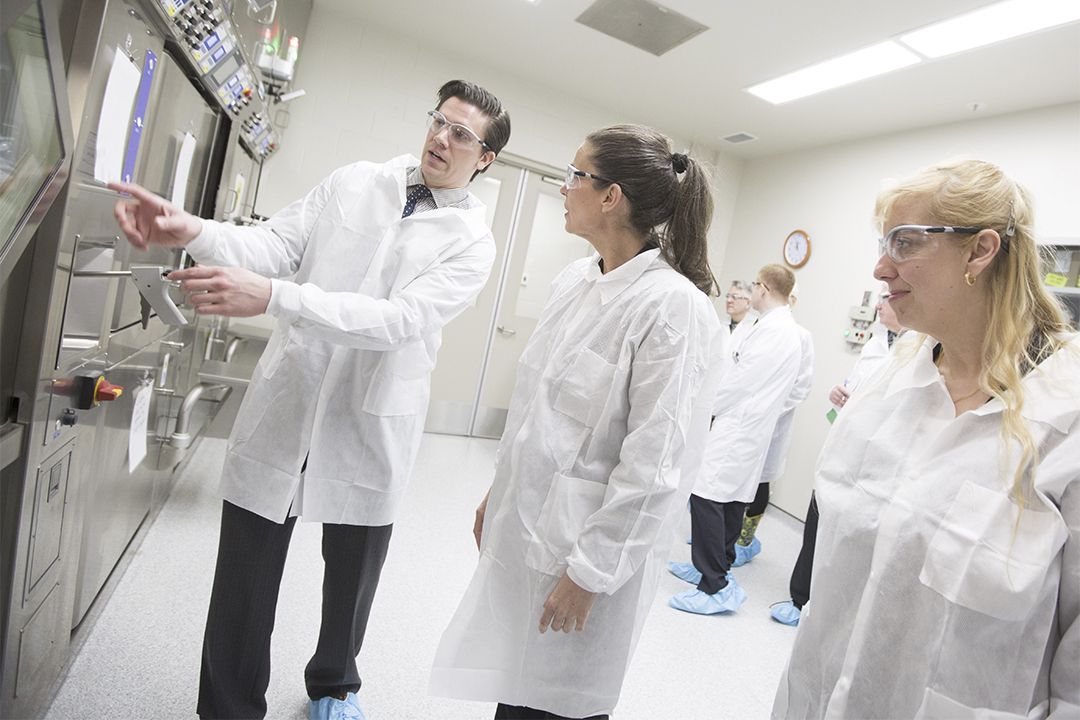The U of S is again on the leading edge of nuclear medicine, thanks to two researchers recently recruited from New York and the state-of-the-art facilities that support their work.
Eric Price and Ekaterina (Kate) Dadachova say the presence of an isotope-producing cyclotron, combined with a radiochemistry “hot” lab at the university’s Saskatchewan Centre for Cyclotron Sciences (SCCS), was the critical factor in bringing them to Saskatoon.
“What makes SCCS a unique facility is that it gives researchers the opportunity to design and ultimately produce new drugs,” said Ghislain Boudreault, manager of the SCCS. “These outstanding researchers are leading teams to design new targeted ‘smart’ drugs for cancer, and in particular are at the forefront of addressing antibiotic-resistant bacterial infections, HIV and fungal infections.”
Recruited to the U of S chemistry department from the Memorial Sloan Kettering Cancer Center research hospital in New York City, Price was named Canada Research Chair in Radiochemistry in December. Meanwhile, the Russian-born and educated Dadachova spent 16 years researching the use of radioimmunotherapy in cancer and pathogen treatment at the Albert Einstein College of Medicine in New York. But lack of access to an isotope-producing cyclotron was a hindrance to expanding the research.
“I came here because there is a major concentration of facilities,” said Dadachova, Fedoruk Chair in Radiopharmacy and a professor in the College of Pharmacy and Nutrition. “I’ve never seen a place where you have in one location a research hospital, a veterinary hospital and a cyclotron, plus a synchrotron.”
With researchers Chris Phenix and Humphrey Fonge already working at the SCCS, the university now has a unique critical mass of researchers in nuclear medicine, Boudreault said. He noted the cyclotron produces fluorodeoxyglucose—or FDG—a radioactive sugar molecule that is delivered five days a week to Royal University Hospital where it is injected into patients undergoing diagnostic imaging Positron Emission Tomography (PET) scans.
Because cancer cells have a higher metabolic rate than normal cells, they take up more of the radioisotope-containing glucose molecule. As a result, during radio- active imaging scans, the tumours glow in stark relief to the rest of the body. This provides a more accurate picture of how far a cancer has advanced compared with using X-rays or CT scans. Metabolic anomalies can be detected at a very early stage, which translates into earlier treatment and saving lives.
A similar approach can also be used to deliver a radioactive drug to cancer or infectious disease sites for treatment purposes, not just for detection of the disease. The key is to find a receptor within the tumour onto which the drug can attach itself. “If you have a molecule that will bind to that receptor, you can piggyback your radioactive isotope onto that,” Price explained. “Instead of having the patient undergo external beam radiation therapy, you can inject the radioisotope into the person and it’s going to go just to the tumour.”
A major area of Price’s research is to develop molecules that chemically tether new radioactive metals onto cancer-targeting proteins, so that they stay tightly attached.
“If the tether is not strong, the (isotopes) come free, and instead of going to the tumours, they go to the bones, the kidneys and cause damage,” he explained.
Dadachova is working with a drug company to continue work begun in New York on human trials of a new radioimmunotherapy for use in patients with metastatic melanoma. She hopes to get approval from Health Canada to continue this human trial with patients at RUH. She is also investigating how radioactive drugs injected into the body can target hard-to-combat pathogens, including fungal infections in immuno-suppressed people and bacterial infections that have become resistant to multiple types of antibiotics.
“There are a lot of multi-drug resistant pathogens. Especially for those patients who are immuno-sup- pressed, you can load them up with antibiotics but nothing will help,” she said. “That’s why we need alternatives for antibiotics and antifungals.”
She sees possibilities for using Western College of Veterinary Medicine research facilities, in collaboration with veterinarian Dr. Elisabeth Snead, to test how promising radioimmunotherapy could destroy fungal infections in companion dogs. This work, which would be a first, could lead to human trials in the future.
Her team in New York made medical news by using a radioimmunotherapy drug to target and destroy both latent and active samples of the HIV virus taken from patients, as well as killing HIV-infected cells behind the experimental human blood brain barrier. She said advancing this work to human trials is especially important because anti-viral drugs, which can suppress HIV for years, do not work in the brain—the place where the virus resides and causes inflammation of nerve tissues.
“A lot of HIV patients experience cognitive decline because the anti-viral drugs cannot cross into the brain. Patients end up in an Alzheimer’s-like state,” she said. “We have to find a way to penetrate the blood brain barrier and kill the infected cells there.”
Murray Lyons is a communications contributor with Research Profile and Impact at the U of S.
